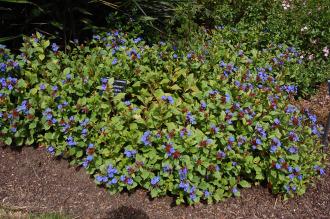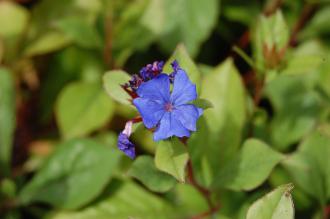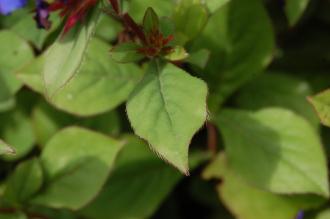
Ceratostigma plumbaginoides (15/08/2015, Kew Gardens, London)
Position: Full sun
Flowering period: Late summer to early august
Soil: Moist, well drained
Eventual Height: 30cm
Eventual Spread: 60cm
Hardiness: 6a, 6b, 7a, 7b, 8a, 8b, 9a, 9b
Family: Plumbaginaceae
Ceratostigma plumbaginoides is a deciduous herbaceous perennial with a spreading habit. Its mid green leaves are ovate with entire / hairy margins, up to 6cm long and 3cm across. Its leaves turn red/ purple in autumn before they fall. Its blue hermaphrodite flowers are tubular and borne terminally in dense clusters. Its fruit is a small bristly capsule containing a single seed.

Ceratostigma plumbaginoides Flower (15/08/2015, Kew Gardens, London)
Ceratostigma plumbaginoides, commonly known as Hardy Blue Flowered Leadwort or Blue Ceratostigma, is native to west China. In its native habitat it grows in rocky places.
The etymological root of the binomial name of Ceratostigma is derived from the Greek keras ‘horn-shaped’ and stigma ‘stigma’, referring to the horn shaped stigma. Plumbaginoides is derived from the Latin plumbus meaning ‘leaden’, in reference to the flower color.
The landscape architect find Ceratostigma plumbaginoides useful as a late flowering ground cover plant. This plant is drought tolerant once established.

Ceratostigma plumbaginoides Leaf (15/08/2015, Kew Gardens, London)
Ecologically, Ceratostigma plumbaginoides flowers are attractive to pollinating insects, including butterflies.
Ceratostigma plumbaginoides was awarded the prestigious Royal Horticultural Societies annual Award of Garden Merit in 1993.
Ceratostigma plumbaginoides prefers moist, fertile, well-drained soil. It tolerates most pH of soil.
Ceratostigma plumbaginoides requires little maintenance. This plant may be cut back hard in the spring to keep a tidy appearance.

Landscape Architecture

